|
Blooms may last longer in cooler climates but cooler climates
do not have the potential for two spectacular bloom periods each
year as South Texas does. Most of us expect our flowering perennials
to bloom well in the spring but overlook the best possible season
for bloom - - fall. Remember, plants are not flowering to make
us happy; they are flowering to produce seed and complete the
reproductive stage of their life cycle. If the old flower stalks
are cut off and not allowed to mature seeds, the plant will attempt
to make more seed. Then we get to enjoy another bloom cycle.
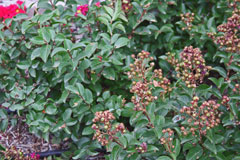
Crapemyrtle seed pods have been removed. |

Seed pods on Pride of Barbados |
Hot weather greatly shortens the life and beauty of blooms. During
the spring bloom season, Texas weather is making the transition
from winter to summer. Unfortunately the transition period may
only be for several days, i.e., Texas temperatures rapidly change
from frosty to scorchy. The fall weather conditions, in comparison,
are ideal for blooms. Usually extremely hot weather ends in September
and the cooler temperatures, especially at night, signal that
the South Central Texas second "spring" has begun. These
cooler temperatures stimulate plant growth and intensify the color
and duration of the blooms. Many people do not prepare their plants
for this second spring so they miss really the most spectacular
bloom period.
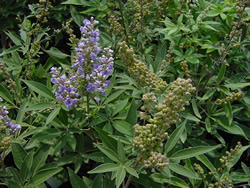
Once plants have flowered and produced seed the plants puts
all of its energy into maturing the seed and does not bloom again. |
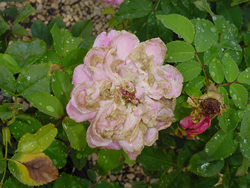
Flower petals burn in the summer sun. |
August is the time to act. Remember, shrubs that bloom after June
usually do so from buds that are formed on shoots that grow the
same year. These shrubs should be pruned in late winter to promote
vigorous shoot-growth in spring. Examples of shrubs that bloom
on current season's growth include: Vitex, Buddleia David or B.
globosa (buddleia or butterfly bush), Hibiscus syriacus (shrub
althea), Hypericum spp. (St. Johnswort), Lagerstroemia indica
(crapemyrtle), and Rosa spp. (roses). There are many examples
of flowering perennials which should be cutback to encourage reblooming.
Fall-blooming perennials, such as Salvia greggii and S. farinancea,
Mexican marigold mint (Tegetes lucida), chrysanthemums, and Salvia
leucantha, should have been pruned periodically during the summer
to keep them compact--if you didn't do that pruning, cut them
back by one-third as soon as possible. Perennial or Summer Phlox
(Phlox paniculata) such as 'John Fanick' or 'Victoria' should
be cut to the ground and allowed to resprout with new stems.
To stimulate rapid re-blooming and more and larger flowers,
one pound (1 cup) of a slow-release formulation of lawn fertilizer
(19-5-9) should be scattered around each large plant or in a 100
square foot planting area after pruning.
CRAPEMYRTLES: Remove as many seed pods as possible from the
crapemyrtles by cutting off the entire stalks on which the pods
are borne. This gets dozens of seed pods at a time rather than
trying to remove them pod-by-pod.
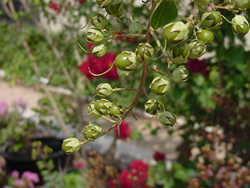
Remove as many seed pods as possible from crapemyrtles by
cutting the entire stalk of seed balls. |
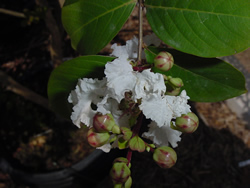
Flower buds can be distinguished from seed balls since seed
balls are hard and flower buds are soft. |

Once 60 percent of the crapemyrtle flowers have produced
seed pods the entire flower stalk should be removed. |
'TEXAS LILAC' VITEX: The 'Texas Lilac' vitex should also be managed
like the crapemyrtles. See: http://www.plantanswers.com/vitex.htm
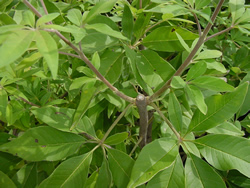
Once the seed stalks have been removed new sprouts will
form and additional flowers will be formed at the terminals
of the new growth. |
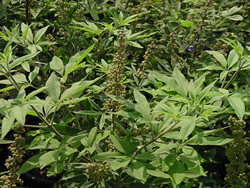
New sprouts will be produced if seed stalks are not removed--however
there will be fewer of them than if all seed stalks were
removed. |
ESPERANZA OR YELLOW BELLS: (Tecoma stans) All of the esperanzas
and especially 'Gold Star' should also be managed like the crapemyrtles.
See:
http://aggie-horticulture.tamu.edu/PLANTanswers/00promotions/tecoma/tecoma.html
I have cut large plants of 'Gold Star' esperanza to the ground
in August and had them blooming profusely as a multi-trunked perennial
in October. The hotter the temperature when it is growing back,
the faster it grows. Remember, after the cutback and/or seed pod
removal, water and fertilize.
HIBISCUS SYRIACUS (shrub althea): This is a plant that is seldom
cut back for fall bloom. Yet it stops blooming after it sets the
seed in the summer-just as crapemyrtles do. Try doing some summer
cutback by thinning out some of the old woody stems and removing
all of the seed pods. Don't forget to fertilize and water. Leave
an abundance of light-brown, pencil size wood.
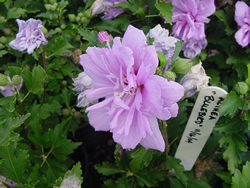
All seed pods and older wood with no buds should be removed
from Shrub Althea. |
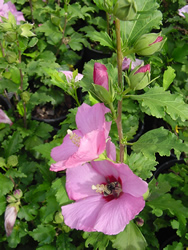
Altheas form buds and bloom on new growth in the spring
-- thus flowers open below maturing buds. |
HIBISCUS ROSA-SINENSIS (Chinese Hibiscus which is tropical and
must be given cold protection) also blooms on new growth so rather
than having to severely cut the plants back in early winter when
the cold weather arrives, why not cut them back in August so they
will be manageable when protection time arrives? Also, when you
do have to move them to cover, you will be protecting blooms and
buds which can provide beauty well into December in this area.
Remember, when you prune the plants back, fertilize regularly
with a water soluble fertilizer such as Miracle Grow, 20-20-20
or Hibiscus Food.
HIBISCUS MOSCHEUTOS (Perennial hibiscus such as 'Moy Grande',
'Flare', 'Red River' which is cut to the ground every winter and
is root hardy all the way to Canada) The concept of severely pruning
this plant after the summer bloom and seed set was first shown
to me by Ying Doon Moy, retired research and development horticulturist
at the San Antonio Botanical Garden. With the exception of 'Flare'
hibiscus, most perennial hibiscus put on a wonderful floral display
in the spring but are then covered with seed pods the rest of
the year until the late fall cutback. Mr. Moy showed me how to
induce fall bloom by simply cutting plants back and removing the
seed pods. This stimulates new shoots from the remaining stems
and an abundant bloom in October when the blooms stay radiant
all day rather than being burnt by the hot summer's afternoon
sun. I cut my plants flat to the ground and force new shoots from
the ground-to Mr. Moy's horror-but I have done this for several
years now and have not lost a plant. Mr. Moy selectively thins
his plants and leaves them about 20 - 24 inches high but I guess
I do not have his patience. Try the "cut it to the ground"
on several of your well-establish perennial hibiscus and see if
it doesn't work well for you. This is especially important if
you have a seed-producing hibiscus such as 'Moy Grande' or 'Red
River'. This late summer cutback also helps with size control
and the amount of cutback you will have to do this winter. Remember,
after the cutback, water and fertilize.
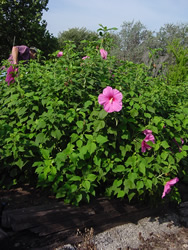
By August perennial hibiscus can become too tall and have
diminished bloom. |
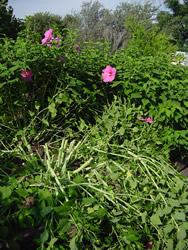
Cut these overgrown hibiscus back to two foot stalks. |
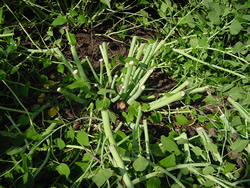
Drastic cutback in August does not damage a well-established
perennial hibiscus. |
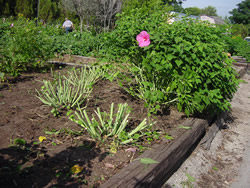
If you are worried about this drastic cutback leave a comparison
plant of the same variety which you do not cut back. |
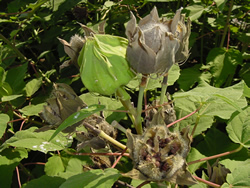
The cutback of perennial hibiscus is especially important
for those seedy varieties such as Moy Grande and Red River. |
ROSA spp. (ROSES) Roses should be pruned or groomed during the
first two weeks in September, no later than September 20. Fall
pruning is lighter than in the spring. Cut about one-fourth to
one-third of the bush. When pruning miniatures, other than cleaning
them out, simply cut off all the blooms. When pruning standard
size roses remove all the blooms and bloom pods. When removing
the recommended one-fourth of the bush cut all canes back to pencil-size
wood if the variety permits, remove any crossing canes which might
rub and damage adjoining canes and remove any dead or diseased
wood. The general shape of a rose bush should be open-centered
or vase-like with canes evenly distributed around the outside.
To prolong the bloom period you may want to prune only one-half
of your rose bush at a time then wait a week to complete the process.
The half which was pruned first will bloom first about 45 days
after pruning occurred. Remember to complete all fall pruning
no later than September 20. Mid-October should begin the peak
rose bloom season. Remove and dispose of all diseased leaves with
black spots on the foliage. Black spot and powdery mildew fungus
must be prevented rather than cured. Prevention is easily accomplished
by using Funginex Fungicide (black Spot and powdery mildew are
fungus diseases) on a 7-l0 day spray schedule. Orthene insecticide
may be added for control of thrips (these cause blooms to stay
closed or be mis-shaped). By September, the spray interval should
be shortened to every 7 days since disease is more prevalent.
Spraying should continue until the first hard freeze occurs.
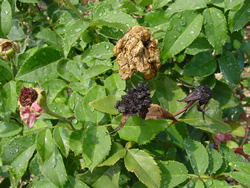
When pruning roses remove all spent blooms and all bloom
pods. |
After fall pruning has been done, give the bushes a "shot
in the arm" with the addition of fertilizer. Feeding with
a water soluble fertilizer should occur every two weeks. Follow
instructions by mixing one tablespoon of water soluble fertilizer
per gallon of water and pour a gallon of solution around each
plant. Don't feed with either liquid or dry fertilizers after
October15th so growth can slow and harden for the winter cold.
If you want more information on growing roses in this area, see:
http://aggie-horticulture.tamu.edu/plantanswers/publications/roses/rose.html
Once you begin to produce these beautiful fall roses it is important
that they be cut properly to insure bloom longevity. When cutting
is done, use sharp tools and allow at least two leaves to remain
between the cut and the main stem. Use sharp shears just above
the topmost leaf. Roses that are cut just before the petals begin
to unfold will open normally and remain in good condition longer.
Late afternoon is the best time of day to cut roses. Always cut
bloom stems back to pencil-sized wood or where five-leaflet leaves
occur. Beginning in mid-November, leave old blooms and pods on
stems to force plants into dormancy. This winterizing will enable
better plant survival in the winter.
Plunge the stems immediately into warm water (about 100 degrees
F.) and cut the stems again an inch or so from the base. Add flower
preservatives according to label instructions if maximum life
is desired. Research has shown that flower preservatives can be
helpful in prolonging the beauty of cut flowers. Such preservatives
can be purchased from retail florists or from floral concessions
in supermarkets. A mixture of 7-Up drink (not the diet type) mixed
equally with water has been shown to be an effective preservative.
It is important for the mixture to stand long enough for most
of the air bubbles to disseminate.
Equally as important as the use of preservatives is a good pure
water source. Rain water, distilled or filtered water should be
used when arranging flowers, since calcium, sodium and other materials
in most tap water can shorten their life. Place the flowers in
a cool, draft free area until ready to use. High temperatures
and direct sun quickly take their toll on cut flowers.
So take action now to insure that you don't miss our second
spring and the beauty of the flowers which can adorn it.
|



